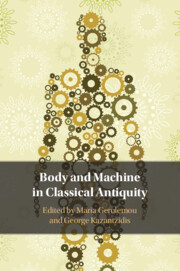Book contents
- Body and Machine in Classical Antiquity
- Body and Machine in Classical Antiquity
- Copyright page
- Contents
- Figures
- Contributors
- An Introduction to Body–Machine Intersections
- Part I Blended Bodies
- Part II The Technological Body
- Part III Towards the Mechanization of the Human Body
- Chapter 7 Aristotle on the Lung and the Bellows–Lungs Analogy
- Chapter 8 The Ill Effect of South Winds on the Joints in the Human Body
- Chapter 9 The Beauty That Lies Within
- Chapter 10 The Mechanics of the Heart in Antiquity
- Chapter 11 The Mechanics of Galen’s Theory of Nutrition
- Chapter 12 Iatromechanism and Antiquarianism in Morgagni’s Studies on Celsus, 1720–1761
- Conclusions or From Antiquity to the Early Modern
- Index of Passages
- General Index
- References
Chapter 12 - Iatromechanism and Antiquarianism in Morgagni’s Studies on Celsus, 1720–1761
from Part III - Towards the Mechanization of the Human Body
Published online by Cambridge University Press: 13 July 2023
- Body and Machine in Classical Antiquity
- Body and Machine in Classical Antiquity
- Copyright page
- Contents
- Figures
- Contributors
- An Introduction to Body–Machine Intersections
- Part I Blended Bodies
- Part II The Technological Body
- Part III Towards the Mechanization of the Human Body
- Chapter 7 Aristotle on the Lung and the Bellows–Lungs Analogy
- Chapter 8 The Ill Effect of South Winds on the Joints in the Human Body
- Chapter 9 The Beauty That Lies Within
- Chapter 10 The Mechanics of the Heart in Antiquity
- Chapter 11 The Mechanics of Galen’s Theory of Nutrition
- Chapter 12 Iatromechanism and Antiquarianism in Morgagni’s Studies on Celsus, 1720–1761
- Conclusions or From Antiquity to the Early Modern
- Index of Passages
- General Index
- References
Summary
Giovanni Baptista Morgagni (1682–1771), Professor of Anatomy at Padua, produced the most important studies in the eighteenth century on the De Medicina of the Roman encyclopediast A. Cornelius Celsus. Morgagni’s intensive reading of Celsus combined his own medical experience with philological emendation. Morgagni contextualized Celsus’ text within a theoretical framework of an empirically ordered transhistorical investigation of the structure, function, and pathology of the human body. Here ancient and modern disciplinary authorities engaged with the same evidence available to the senses. Morgagni’s argument in part contrasted Celsus’ humoralist evidence that bladder stones originate in the substance of the urine with Friedrich Hoffmann’s (1660–1742) argument that bladder stones originate in the iatromechanist action of the kidneys. Morgagni’s emendations continue to mark our own contemporary editions of Celsus’ Latin text.
- Type
- Chapter
- Information
- Body and Machine in Classical Antiquity , pp. 296 - 317Publisher: Cambridge University PressPrint publication year: 2023

